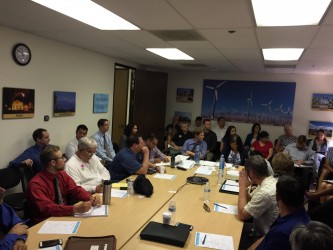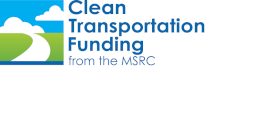In recent years there has been a trend toward incorporating active transportation into people’s lifestyles – whether it’s getting more people to ride their bikes to get around town or to walk to work – active transportation is more popular than ever. And the MSRC is following this trend by offering funding in its Work Programs for several active transportation programs.
Active transportation programs are designed to encourage people to get out of their cars and bike or walk to some of their destinations. By creating and fostering an interconnected system that caters to the needs of pedestrians and bicyclists that is well integrated with public transit, more people are likely to adopt active modes of transportation. The purpose of these types of programs can include: increasing the number of trips taken by biking and walking, thus lowering the number of car trips taken; improving the safety and mobility for non-motorized users; lowering emissions and helping achieve greenhouse gas reduction goals by reducing the number of vehicles on the road; and enhancing public health by getting people more active.
The MSRC is working to help achieve these goals through its active transportation program, which has been a part of its Work Program for many years. As part of the 2015 Local Government Match Program., eligible active transportation projects included “complete streets” pedestrian access projects, bicycle and related projects such as bike lanes, bike infrastructure, and bikesharing programs, and outreach and education projects.
 In the past, the MSRC has offered funding to public agencies specifically for transit-oriented bikeshare programs to promote the use of bicycles as the link between commuters’ home and work and public transit stations to close the first mile-last mile gap. Other innovative active transportation projects the MSRC has funded include the former "BikeMetro" website, an internet bicycle routing and mapping program that was ahead of its time, available before Google bike map functions were handy, and providing electric bicycles, along with traditional bikes, to law enforcement agencies.
In the past, the MSRC has offered funding to public agencies specifically for transit-oriented bikeshare programs to promote the use of bicycles as the link between commuters’ home and work and public transit stations to close the first mile-last mile gap. Other innovative active transportation projects the MSRC has funded include the former "BikeMetro" website, an internet bicycle routing and mapping program that was ahead of its time, available before Google bike map functions were handy, and providing electric bicycles, along with traditional bikes, to law enforcement agencies.
Other programs throughout the state are also joining the active transportation movement. California developed its own statewide Active Transportation Program (ATP) in 2013, funded by federal programs and State Highway Account funds, and administered by Caltrans. Eligible projects include infrastructure, plan development such as bicycle, pedestrian, safe routes to school, and active transportation plans in disadvantaged communities, and non-infrastructure projects such as education and enforcement. For the first round of available funding in 2014, 265 projects were awarded $367.97 million in funding. Awards for the 2015 ATP program will be announced in the fall.
Just last month, the City of Los Angeles adopted its new Mobility Plan 2035, which revises the 1999 transportation element of the city’s general plan. The plan incorporates “complete streets” principles to balance the needs of all road users, including motorists, bicyclists and pedestrians. It is intended to guide the city and other agencies in allocating scarce resources when determining future mobility improvements. Relative to current levels, it is estimated that the plan will help increase transit trips by 50 percent, increase bicycle trips by 150 percent, and increase walking trips by 25 percent. The plan aims to reduce the number of vehicle miles driven by 600 million miles per year.
The Los Angeles County Metropolitan Transportation Authority (Metro) is currently developing its own Active Transportation Strategic Plan. The plan is a county-wide effort to identify strategies to increase walking, bicycling and transit use in Los Angeles County. It will focus on improving first and last mile access to transit and propose a regional network of active transportation facilities, including shared-use paths and on-street bikeways, and develop a funding strategy to build them. Metro recently concluded the first round of public workshops this summer and more workshops will take place in the fall and next spring. The plan is slated to be completed by mid-2016.
The Riverside County Active Transportation Network kicked off its inaugural meeting in mid-August (see photo). Participants included city and county staff members, Caltrans representatives, bicycle groups, councils of government, and other stakeholders. Their mission is to improve the quality of life in Riverside County by promoting active modes of transportation, meaning human-powered modes like biking and walking. Funding opportunities were discussed, as well as active transportation planning that is underway in the South Coast region. The group will be meeting quarterly - November 18 is the next scheduled meeting.
This sampling of active transportation activities that are taking place at the state and regional level demonstrates how policy leaders are thinking differently about transportation for the future – it will be a multi-modal approach rather than vehicle-centric as it has been in the past. The MSRC is already a playing a role in this vision for the future by funding bicycle and pedestrian programs now to help accelerate the widespread adoption of active transportation solutions for communities throughout Southern California.
